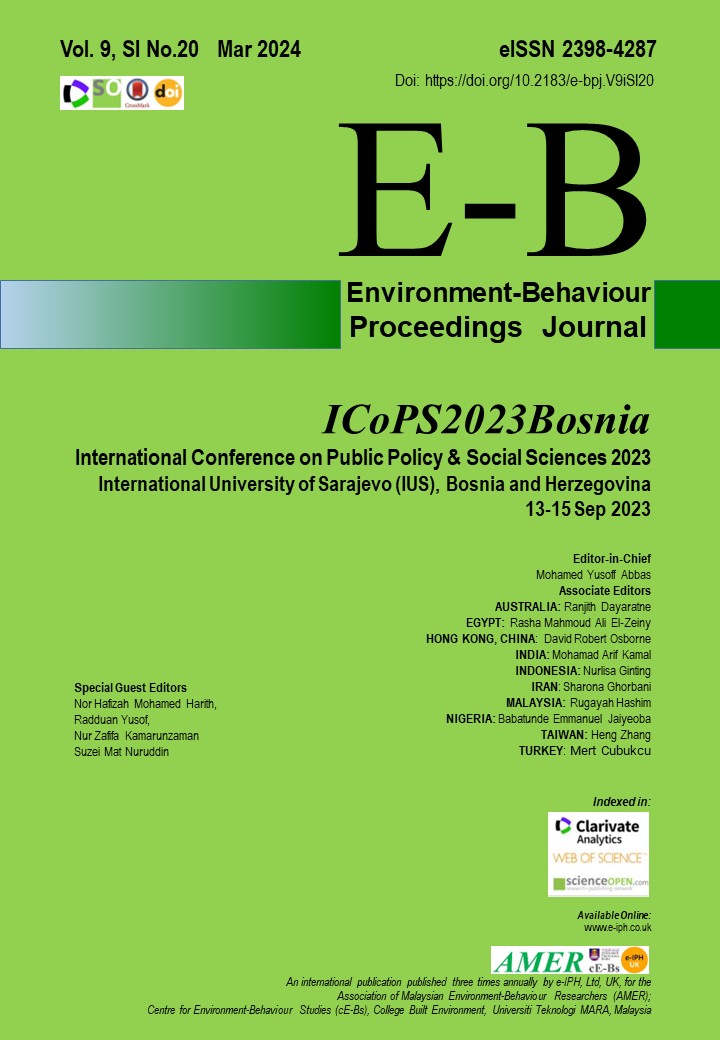Exploring Interactive Roles in the Communication Through Drama Online Classroom in Universiti Teknologi MARA, Malaysia
DOI:
https://doi.org/10.21834/e-bpj.v9iSI22.5815Keywords:
Interactive Roles, Social Constructivist, Visible Thinking, Focus Group DiscussionsAbstract
This qualitative study aims to identify and categorize interactive roles within a Malaysian tertiary drama classroom. It examines the impact of virtual interaction on students' language learning experiences when using drama to improve communication. Employing focus group discussions as the primary data collection method, this research involves 20 undergraduates enrolled in the Communication Through Drama (EPC522) course offered under the LG240 program, i.e., the Bachelor of Applied Language Studies-English for Professional Communication (Hons) in Akademi Pengajian Bahasa, Universiti Teknologi MARA, Shah Alam, Selangor, Malaysia. The study is based on the Social Constructivist theory by Vygotsky (1962, 1978) and the Visible Thinking (VT) approach identified by Ritchhart (2006) as part of Project Zero (PZ) at Harvard University. Online platforms and tools utilized for interactive drama activities are specified in the study. The findings reveal the challenges faced in completing drama activities online and demonstrate that the implementation of VT routines enhances students' interactive roles and communication skills. Despite the challenges, students embraced this new educational experience that fosters a more interactive and student-centered environment. The implications of these findings for language education and drama pedagogy in Malaysia are discussed.
References
Akpan, V. I., Igwe, U. A., Mpamah, I. B. I., & Okoro, C. O. (2020). Social Constructivism: Implications On Teaching And Learning. British Journal of Education, 8(8), 49–56. https://www.eajournals.org/wp-content/uploads/Social-Constructivism.pdf
Anderson, G. J. (2002). Fundamentals of educational research. Routledge Falmer.
Berg, G. V. D. (2020). Context Matters: Student Experiences of Interaction in Open Distance Learning. Turkish Online Journal of Distance Education, 223–236. https://doi.org/10.17718/tojde.803411 DOI: https://doi.org/10.17718/tojde.803411
Bestock, S. (2020). Teaching Drama in Distance Learning. Edutopia. https://www.edutopia.org/article/teaching-drama-distance-learning
Braun, V., & Clarke, V. (2006, January). Using thematic analysis in psychology. ResearchGate. DOI: https://doi.org/10.1191/1478088706qp063oa
https://www.researchgate.net/publication/235356393_Using_thematic_analysis_in_psychology
Cherry, K. (2022, November 7). How to Write a Psychology Case Study. Verywell Mind; Verywell Mind. https://www.verywellmind.com/how-to-write-a-psychology-case-study-2795722
Creswell, J. W. (2018). Educational Research: planning, conducting, and evaluating quantitative and qualitative research. Pearson.
Creswell, J. W. (2014). Research Design: Qualitative, Quantitative, and Mixed Methods Approaches (4th ed.). Sage Publications Ltd.
Cultures of Thinking/ Project Zero. (n.d.). Pz.harvard.edu. https://pz.harvard.edu/projects/cultures-of-thinking
Dagar, V., & Yadav A. (2016). Constructivism: A Paradigm for Teaching and Learning. Arts and Social Sciences Journal, 7(4). https://www.academia.edu/44035677/Constructivism_A_Paradigm_for_Teaching_and_Learning DOI: https://doi.org/10.4172/2151-6200.1000200
Dass, L. C. (2021). Project Zero: A Framework for Innovative Pedagogy in the Teaching of English in Malaysia? Malaysian Journal of ELT Research, 18(1), 17–35. https://doi.org/10.52696/bqug1201 DOI: https://doi.org/10.52696/BQUG1201
Gholam, A. (2018). Student Engagement through Visual Thinking Routines. Athens Journal of Education, 5(2), 161–172. https://doi.org/10.30958/aje.5-2-4 DOI: https://doi.org/10.30958/aje.5-2-4
Gustafsson, J. (2017). Single case studies vs. multiple case studies: A comparative study. http://www.diva-portal.org/smash/get/diva2:1064378/FULLTEXT01.pdf
Ladder of Feedback/ Project Zero. (n.d.). Pz.harvard.edu. https://pz.harvard.edu/resources/ladder-of-feedback
Liamputtong, P., & Ezzy, D. (2007). Qualitative research methods (2nd ed.). Oxford University Press.
Mala Rejeki Manurung, Siti Masitoh, & Fajar Arianto. (2022). Using Thinking Routines To Improve The Reading And Writing Skills Of Elementary Students. 33(3), 153–153. https://doi.org/10.12962/j20882033.v33i3.14953 DOI: https://doi.org/10.12962/j20882033.v33i3.14953
Maley, A., & Duff, A. (1982). Drama techniques in language teaching. Cambridge University Press.
Miller-First, M., & Ballard, K. (2017). Constructivist Teaching Patterns and Student Interaction. Internet Learning, 6(1). https://doi.org/10.18278/il.6.1.3 DOI: https://doi.org/10.18278/il.6.1.3
MOE - Malaysia Education Blueprint 2013-2025. (n.d.). Www.moe.gov.my. https://www.moe.gov.my/en/dasarmenu/pelan-pembangunan-pendidikan-2013-2025
Muhammad Azri Ali (2021). Students’ Learning Experience in Introduction to Drama Theatre Classes During COVID-19. Journal of Cognitive Sciences and Human Development, 7(1), 123–133. https://doi.org/10.33736/jcshd.3040.2021 DOI: https://doi.org/10.33736/jcshd.3040.2021
Ritchhart, R., & Church, M. (2020). The Power of Making Thinking Visible: Practices to engage and empower all learners. Jossey-Bass, A While Brand.
Schreiber, L. M., & Valle, B. E. (2013). Social Constructivist Teaching Strategies in the Small Group Classroom. Small Group Research, 44(4), 395–411. https://doi.org/10.1177/1046496413488422 DOI: https://doi.org/10.1177/1046496413488422
Think, Pair, Share/ Project Zero. (n.d.). Pz.harvard.edu. https://pz.harvard.edu/resources/think-pair-share
Yee, C. P. (2020). Covid-19: Impact on the Tertiary Education Sector in Malaysia – Penanginstitute.org. https://penanginstitute.org/publications/covid-19-crisis-assessments/covid-19-impact-on-the-tertiary-education-sector-in-malaysia/
Vygotsky, L. S. (1978). Mind in Society. Harvard University Press.
Vygotsky, L. S. (1962). Thought and language. MIT Press, Massachusetts Institute Of Technology. DOI: https://doi.org/10.1037/11193-000
Zakhareuski, A. (2018). 5 Reasons to Incorporate Drama in Your ESL Classroom. Busy Teacher https://busyteacher.org/22740-5-reasons-to-incorporate-drama-inthe-esl.html
Downloads
Published
How to Cite
Issue
Section
License
Copyright (c) 2024 Zaamah Mohd Nor, Laura Christ Dass, Noor Ahnis Othman

This work is licensed under a Creative Commons Attribution-NonCommercial-NoDerivatives 4.0 International License.





